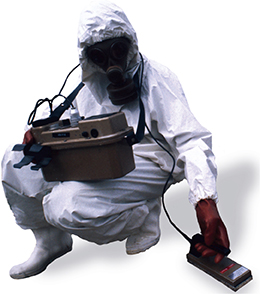When exposure to nuclear radiation is external, the amount of tissue damage depends on the penetrating power of the radiation. For example, beta particles can damage tissues in the body more than alpha particles, but less than gamma rays. Gamma rays can penetrate deeply into the human body, potentially exposing all organs to ionization damage.
Detecting Nuclear Radiation
Although you can't see, hear, or feel the radioactivity around you, scientific instruments can measure nuclear radiation.  Devices that are used to detect nuclear radiation include Geiger counters and film badges. A Geiger counter, shown in Figure 7, uses a gasfilled tube to measure ionizing radiation. When nuclear radiation enters the tube, it ionizes the atoms of the gas. The ions produce an electric current, which can be measured. The greater the amount of nuclear radiation, the greater the electric current produced in the tube is.
Devices that are used to detect nuclear radiation include Geiger counters and film badges. A Geiger counter, shown in Figure 7, uses a gasfilled tube to measure ionizing radiation. When nuclear radiation enters the tube, it ionizes the atoms of the gas. The ions produce an electric current, which can be measured. The greater the amount of nuclear radiation, the greater the electric current produced in the tube is.
Recall that in Becquerel's experiment, nuclear radiation left an image on a photographic plate. Today, many people who work with or near radioactive materials wear film badges to monitor their exposure to nuclear radiation. A film badge contains a piece of photographic film wrapped in paper. The film is developed and replaced with a new piece periodically. The exposure on the film indicates the amount of radiation exposure for the person wearing the badge.
Figure 7 Wearing protective clothing, a firefighter uses a Geiger counter to test the ground for radioactivity. Firefighters sometimes help clean up accidents involving radioactive materials.

Section 10.1 Assessment
Reviewing Concepts
 How does an element change during nuclear decay?
How does an element change during nuclear decay? What are three types of nuclear radiation?
What are three types of nuclear radiation? How are atoms affected by nuclear radiation?
How are atoms affected by nuclear radiation? What devices can be used to detect nuclear radiation?
What devices can be used to detect nuclear radiation?How do types of nuclear radiation differ in electric charge?
Describe the penetrating power of each common type of radiation.
What is background radiation? List some of its sources.
Critical Thinking
Predicting What is the effect of beta decay on the composition of a nucleus?
Inferring Why do you think airplane pilots wear film badges?
Math Practice
Write a balanced nuclear equation for the alpha decay of radium-226.
Write a nuclear equation that describes the beta decay of hydrogen-3.




